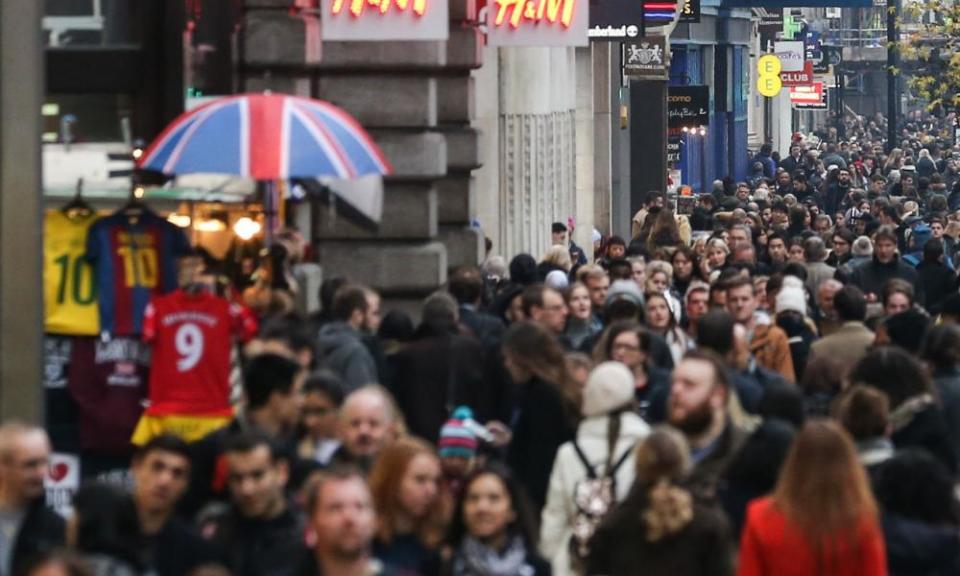'Britain is fast becoming the sick man of Europe' – experts debate Brexit data

David Blanchflower
Professor of economics at Dartmouth College, New Hampshire, and member of the Bank of England’s monetary policy committee from June 2006 to May 2009
I keep waiting for the good news that the Brexiters told us would come once the vote to leave the EU was in. The vote was an unexpected shock to the markets that was always going to take a while to work its way into the main economic data. A year on, Britain is the slowest-growing country in both the G7 and the EU28. In the first quarter of 2017, the UK grew 0.2%, whereas the eurozone grew by 0.6%. As a result of the Brexit vote and the economic uncertainty it unleashed, Britain is fast becoming the sick man of Europe. That seems unlikely to change soon.
Once again this month, there is only thin economic gruel in the data. The UK economy is continuing to be impacted by the fall in the pound post-Brexit, which has raised import prices, resulting in a temporary rise in inflation. The consumer prices index came in at 2.6% for June which was below what most commentators had expected. But the latest estimate for nominal wage growth, that is not adjusted for price changes, for May fell to 1.8% down from 2.1% in April. Real wage growth started falling in April at -0.3% and the rate of decline accelerated in May to -0.7%. UK productivity performance continues to be disastrous, dropping back to where it was at the end of 2007. Output per worker fell 0.5% in the first three months of 2017. The French continue to produce in four days what Britain produces in five.
The major consequence of this is likely to be a fall in demand going forward. The latest retail sales numbers suggested a pickup in June with decent weather after a disastrous May. But, on the year, sales are broadly flat and going nowhere. The rise in unsecured borrowing is likely coming to an end. The savings rate, which is at historically low levels, is inevitably going to pick up as people start saving for a rainy day driven by Brexit uncertainty. Industrial production is falling. There is no floor in sight.
The concern is that the monetary policy committee has little firepower to help if things get worse with rates so close to zero, and the chancellor seems to be awol. Here’s hoping.
Andrew Sentance
Senior economic adviser at the PwC consultancy and member of the Bank’s MPC from October 2006 to May 2011
The evidence from business surveys and other economic indicators is consistent with continued slow growth in the UK economy in the second quarter. PwC’s “nowcast” of GDP growth points to a 0.3% increase in Q2, after 0.2% in Q1. That is equivalent to annualised growth of just 1% in the first half of this year, less than half the average growth rate of around 2.5% which the UK economy enjoyed from 2013 until 2016.
The squeeze on consumer spending from higher inflation is one of the key drivers of the slowdown. Even though retail sales picked up in June, this was only a partial recovery from the drop in May. The average level of retail sales volumes in the first half of this year is almost identical to the second half of 2016. In other words, the underlying trend is flat, after three years (2014 to 2016) when average retail sales growth was nearly 4.5% a year.
It is not hard to explain why the momentum of consumer spending has stalled so badly. Real wages are now falling, even though inflation fell back to 2.6% in June. The main reason for the fall in inflation was the drop in the oil price, but it is still reasonable to expect inflation to rise above 3% later this year as the weakness of sterling continues to feed through to the prices paid by consumers.
The employment figures paint a more positive picture, with the jobless rate dropping to 4.5% – the lowest we have seen for more than 40 years. But if slow growth continues through this year, as seems likely, unemployment is likely to start edging up. The jobs market is normally a lagging indicator of the economy, so the weakness in GDP growth in the first half of this year is likely to put a dampener on job creation in the remainder of 2017.

 Yahoo Finance
Yahoo Finance 